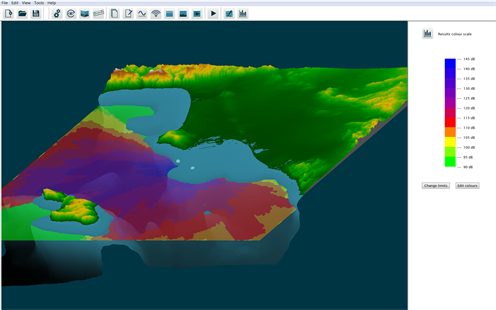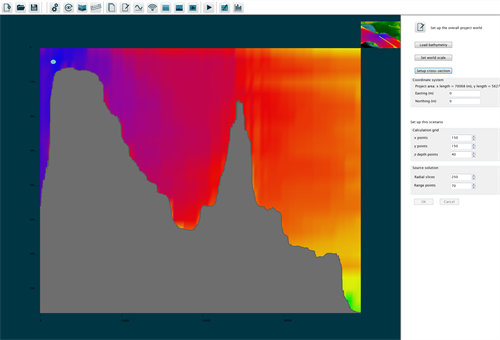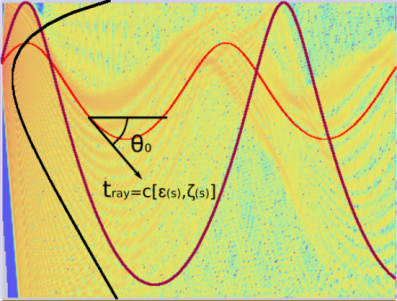dBSea
Underwater noise
Despite what most people think the sea below surface is not very quiet. A lot of the sound sources are natural and is part of the background noise in the sea. Examples of natural noise sources are rain, interaction between wind and waves and also vulcanic activity can cause noise on far distance.
Many forms of marine life depend on sound for their communication, navigation and development. Noise generated by man can obstruct these vital functions and biologists are concerned about both physiological disorders as disorders in animal behavior. Especially in marine mammals, many species have very sensitive hearing. Noise generated by man in underwater environments include noise from ship traffic, pile driving and seismic surveys with impulse sources. EU Marine Directive descriptor 11 dictate that noise in the seas must not harm marine life. dBSea is a tool to comply with this Directive.
Prediction of underwater sound propagation
dBSea has been developed by acoustics professionals for acoustics professionals. The user friendly interface allows rapid modelling of problems including data import & export, input of noise sources, definition of propagation properties and exporting of results.

Main Features
The model is represented in 3D and may be rotated and zoomed to allow easy navigation of the problem environment and examination of prediction results. Where previous analysis has been limited to individual calculation slices or transects, dBSea allows the entire problem environment to be modelled and analysed in 3D.
The 3D model is built by importing bathymetry data and placing noise sources in the environment. Each source can consist of equipment chosen from either the standard or user defined databases. Noise mitigation methods may also be included. The user has control over the seabed and water properties including speed of sound profile (how the speed of sound changes with water depth), temperature, saltinity and current.
Noise levels are calculated throughout the entire project area and displayed in 3D. To examine results in more detail, levels may be plotted in cross sections or a detailed spectrum may be extracted at any point in the 3D calculation area.

Levels are calculated in octave or third octave bands. Three different solvers are available and the user may choose different solvers for the low and high frequency ranges. Levels are compared to hearing thresholds of a number of common marine species to give overall dBht levels.
Special Features
dBSea offers elegant ways to export calculation results. The user can generate a summary of the calculations for every point in the 3D calculation area. Results are produced in a format that is ready to be transferred to other software such as MS Excel or Word.
Graphical export is available to a range of formats (JPG, PNG, GIF, PDF). With the 3D graphics capabilities of dBSea, it is simple to create elegant report data showing sound levels and exclusion zones.

Technical info
dBSeaPE - parabolic equation method
The dBSeaPE solver makes use of the parabolic equation method, a versatile and robust method of marching the sound field out in range from the sound source. This method is one of the most widely used in the underwater acoustics community, and offers excellent performance in terms of speed and accuracy in a range of challenging scenarios.
dBSeaRay - ray tracing method
The dBSeaRay solver forms a solution by tracing rays from the source to the receiver. A large number of rays leave the source covering a range of angles, and the sound level at each point in the receiving field is calculated by coherently summing the components from each ray.

dBSeaModes - normal modes method
The normal modes are calculated for each water depth, based on the sediment properties and water sound speed profile. The sound field is calculated by assuming that energy only travels outward from the source, and that energy is not passed between modes (adiabatic assumption), leading to coupled mode equations.
As an aid to the user, two rapid solvers (20 log and 10 log) are included for quick evaluation of problems.
More info about dBSea on the developers website http://www.dbsea.co.uk/